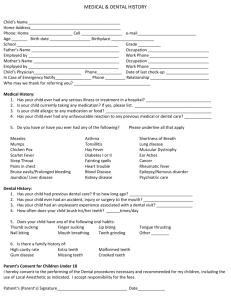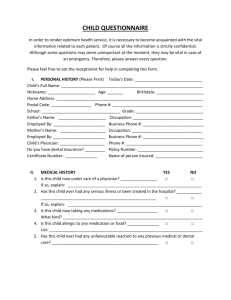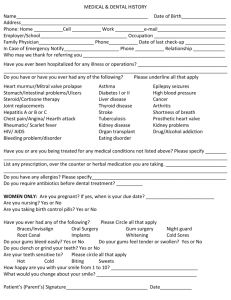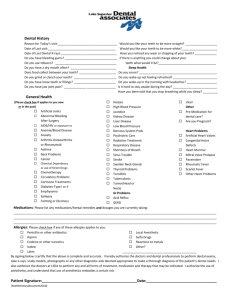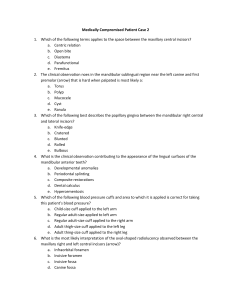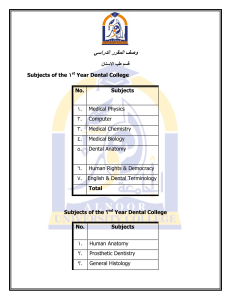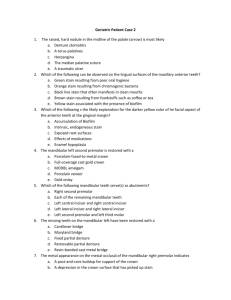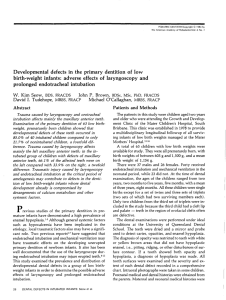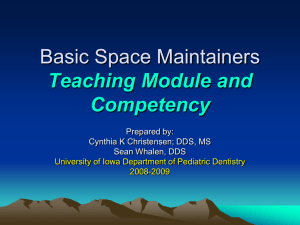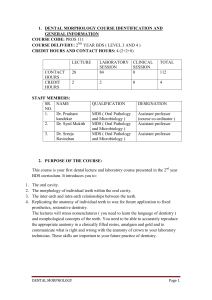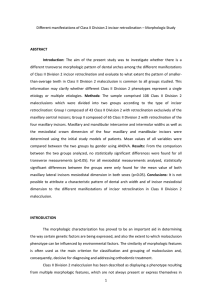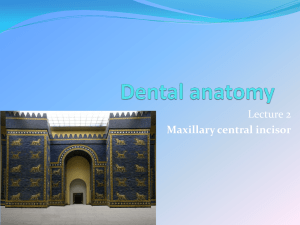Questions
advertisement
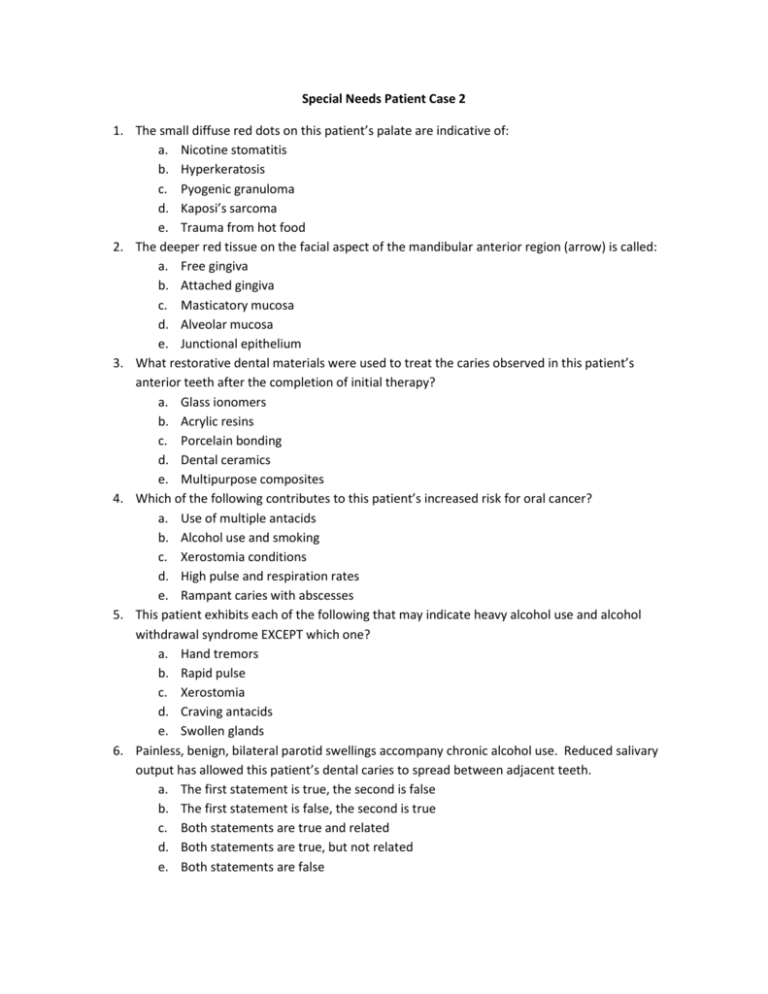
Special Needs Patient Case 2 1. The small diffuse red dots on this patient’s palate are indicative of: a. Nicotine stomatitis b. Hyperkeratosis c. Pyogenic granuloma d. Kaposi’s sarcoma e. Trauma from hot food 2. The deeper red tissue on the facial aspect of the mandibular anterior region (arrow) is called: a. Free gingiva b. Attached gingiva c. Masticatory mucosa d. Alveolar mucosa e. Junctional epithelium 3. What restorative dental materials were used to treat the caries observed in this patient’s anterior teeth after the completion of initial therapy? a. Glass ionomers b. Acrylic resins c. Porcelain bonding d. Dental ceramics e. Multipurpose composites 4. Which of the following contributes to this patient’s increased risk for oral cancer? a. Use of multiple antacids b. Alcohol use and smoking c. Xerostomia conditions d. High pulse and respiration rates e. Rampant caries with abscesses 5. This patient exhibits each of the following that may indicate heavy alcohol use and alcohol withdrawal syndrome EXCEPT which one? a. Hand tremors b. Rapid pulse c. Xerostomia d. Craving antacids e. Swollen glands 6. Painless, benign, bilateral parotid swellings accompany chronic alcohol use. Reduced salivary output has allowed this patient’s dental caries to spread between adjacent teeth. a. The first statement is true, the second is false b. The first statement is false, the second is true c. Both statements are true and related d. Both statements are true, but not related e. Both statements are false 7. The reddening of the tip of this patient’s tongue and the burning sensation is most likely the result of: a. Cigarette smoking b. Use of antacids c. Folic acid deficiency d. Excessive alcohol intake e. Geographic tongue 8. The radiolucency observed at the apex of the mandibular left lateral incisor (arrow) is most likely: a. A periapical abscess b. Condensing osteitis c. A residual cyst d. The lingual frenum e. The mental foramen 9. Each of the following teeth exhibits caries at the initial appointment, before the patient has his teeth restored, EXCEPT which one? a. Maxillary right lateral incisor b. Maxillary right central incisor c. Maxillary left central incisor d. Mandibular left central incisor e. Mandibular left lateral incisor 10. A nonalcohol preprocedural rinse is indicated because of this patient’s alcohol use pattern. a. The statement is true, the reason is false b. The statement is false, the reason is true c. Both the statement and reason are true and related d. Both the statement and reason are true, but not related e. Both the statement and reason are false 11. Which of the following can be added to this patient’s diet to address his vitamin deficiency related to his burning tongue symptom? a. Sunlight exposure b. Liver meats c. Green vegetables d. Multiple vitamins e. Folate supplements 12. Each of the following is a potential barrier to care planning for this patient EXCEPT which one? a. Limited finances b. Ability to keep appointments and follow through with treatment c. Aerosols and allergens present in the facility d. Liver impairment and bleeding potential e. Emotional stability during appointments 13. Which of the following is the leading cause of this patient’s multiple carious lesions? a. Alcohol consumption 14. 15. 16. 17. 18. 19. b. Xerostomia c. Lack of professional care d. Tobacco use e. Poor oral self-care Which of the following possible medical emergencies should be considered when treating this patient? a. Alcohol withdrawal syndrome b. Airway obstruction c. Adrenal crisis d. Anaphylaxis e. Asthma Which of the following is the most likely reason this patient has difficulty keeping his scheduled dental hygiene appointments? a. Lack of knowledge regarding the importance of oral health b. Embarrassment about the condition of his smile c. Negative dental experiences as a child d. Preoccupation with drinking e. Fear of being in pain When scaling the maxillary left posterior buccal aspects, the dental hygienist should refrain from fulcruming a. In the maxillary left canine/premolar area b. With the palm of the hand on the patient’s chin c. On the maxillary left incisors d. With the ring finger resting on the index finger of the nondominant hand Following the preliminary prophase of periodontal procedure sequencing where periapical emergencies are treated, this patient will enter which of the following treatment phases? a. Phase I non-surgical initial therapy b. Phase II surgical and corrective therapy c. Phase III restorative care d. Phase IV maintenance therapy Which of the following self-care agents should be recommended for this patient? a. Peridex b. Viadent c. Listerine d. Scope e. Gel-Kam Which of the following should be recommended for this patient? a. Tarter control dentifrice b. Fluoride varnish c. Sealants d. Locally delivered antimicrobial therapy e. Antifungal palliative care for the tongue 20. If stains are present on this patient’s new anterior restorations at the next recall appointment, they can be removed with a(an) a. Ultrasonic scaler at high power b. Sonic scaler at low power c. Rubber cup and fine-grit abrasive d. Toothbrush and tarter-control toothpaste e. Air polisher and sodium bicarbonate 21. Which of the following should NOT be recommended for this patient? a. Fluoride supplementation b. Reduced alcohol consumption c. Tobacco cessation program d. Tooth-whitening procedures e. Nutritional counseling 22. Which of the following should be this patient’s first referral? a. Physician b. Dietician c. Endodontist d. Alcoholism recovery group e. Smoking cessation classes 23. Because alcohol use can affect oral conditions and impact oral hygiene treatment, tis patient’s health history should be followed up with each of the following questions EXCEPT which one? a. “When was your last drink?” b. “How often do you drink?” c. “How much do you drink?” d. “What types of alcohol do you consume?” e. “What is your pattern of alcohol consumption?” 24. Which of the following is the most likely reason this patient did not have his anterior teeth restored with porcelain veneer crowns or full porcelain-fused-to-metal crowns? a. The dentist and oral health care team knew that the patient could not afford crowns, so they did waste time telling him about this treatment option b. The patient was willing to forego the best dental treatment (crowns) to use his financial resources on some other nondental needs c. Because this patient is at risk for keeping appointments, the dental hygienist recommended that he not put himself through the process of multiple appointments for fabricating the crowns d. Composite restorative dental materials currently on the market make this the better choice over crowns for these carious anterior teeth e. This patient is not capable of understanding the need for comprehensive restoration of these badly decayed teeth ANSWERS 1.A 2.D 3.E 4.B 5.D 6.A 7.C 8.A 9.D 10.C 11.E 12.C 13.B 14.A 15.D 16.C 17.A 18.E 19.B 20.C 21.D 22.A 23.D 24.B

